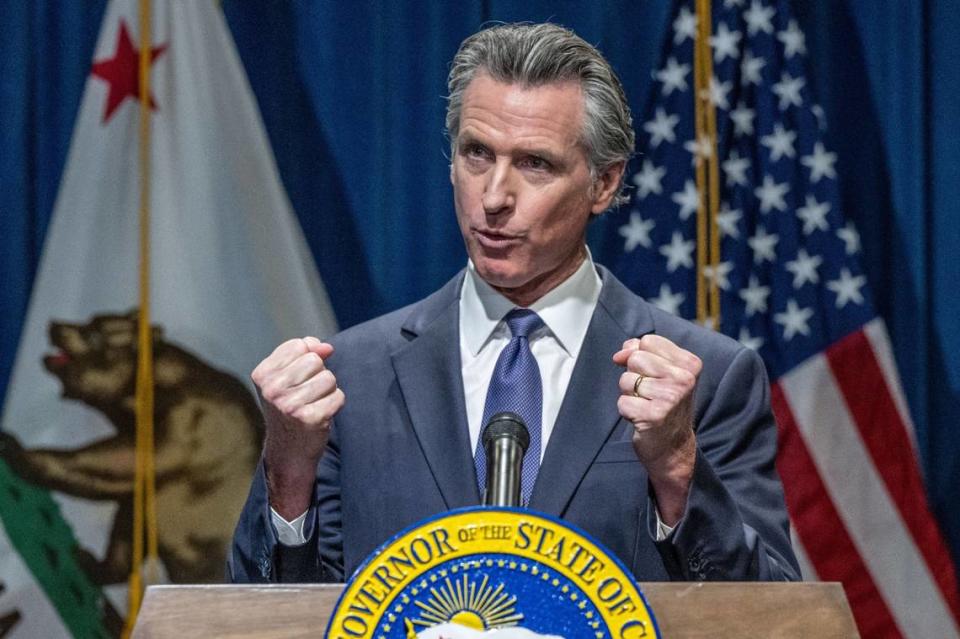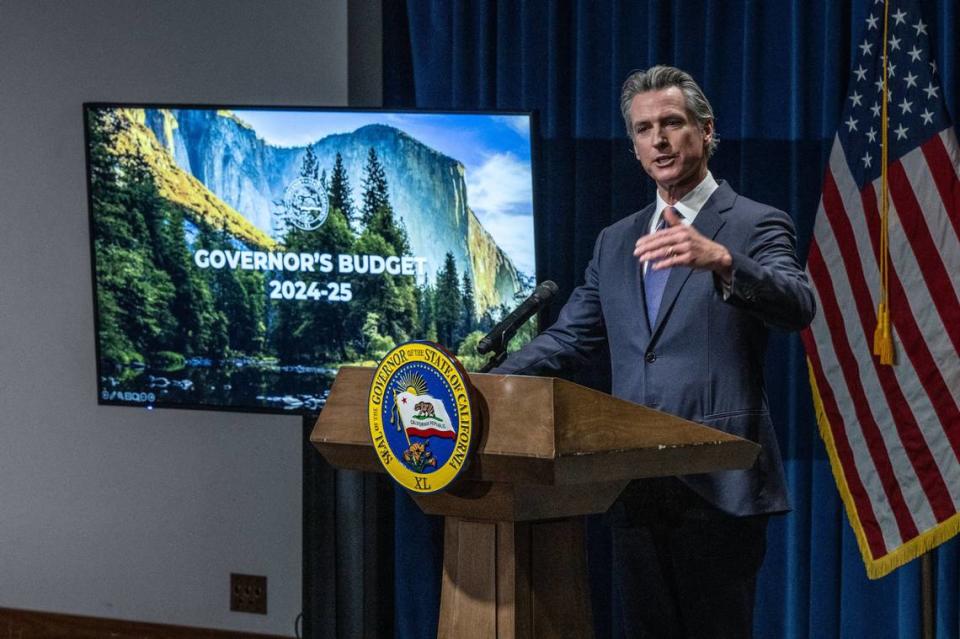Gavin Newsom reveals plan to fix California spending deficit. What’s in his $291 billion budget
- Oops!Something went wrong.Please try again later.
California Gov. Gavin Newsom on Wednesday unveiled a $291.5 billion budget to close a $37.9 billion shortfall by dipping into the state’s reserves and cutting and delaying spending.
It’s the second budget year in a row Newsom is walking an economic tightrope between closing a large spending gap and keeping financial promises he made during more prosperous times.
His budget preserves a handful of costly programs his administration enacted, including a Medi-Cal expansion for undocumented immigrants.
But it cuts $8.5 billion from a variety of funds, including reductions to climate change and housing programs and school facilities. It also delays and defers more than $7 billion in funding for transit and intercity rail, early childhood education grants, clean energy and behavioral health housing.
Newsom’s budget also withdraws $13 billion from the state’s reserves, a move he and legislative leaders avoided when dealing with last year’s spending gap. Newsom will need to declare a fiscal emergency to access $10.4 billion of that amount, a move he said he would make “when we need to, but not for many, many months” as he negotiates the final budget with legislative leaders.
He remained staunchly opposed to raising taxes, sometimes expressing exasperation at media questions about increasing revenue, especially in regard to a proposed wealth tax.
“I’m just not going to say it again,” Newsom said. “Because I say it every year.”
Last year, the governor soberly laid out a plan to address an estimated $22.5 billion deficit — a stark change from the celebratory budget announcements of surpluses past.
This time, Newsom was back in a similar place, but with an often defiant demeanor as he explained his plan during a two-hour news conference. He outlined the cause and effect of a deficit that is more than $15 billion higher than the spending gap he dealt with in January 2023. The state budget must be balanced.
The governor is facing tough economic conditions caused mostly by financial hits wealthy Californians have experienced in a post-COVID-19 pandemic economy, the state’s Legislative Analyst’s Office reported in December.
The state’s progressive tax structure makes its budget uniquely dependent on income taxes from the highest earners. Stock market uncertainty and higher interest rates have lowered their tax payments, as they receive income from capital gains and dividends.
California in the fall was to receive billions in delayed tax revenue after the federal Internal Revenue Service allowed those affected by severe winter storms to defer filing. When receipts came in under expectations, the $31.5 billion spending gap state leaders projected in May ballooned significantly.
The governor characterized the budget year as a “story of correction, of normalization.”

Social safety net programs
The governor remained committed to expanding Medi-Cal to all residents, regardless of immigration status, one of his administration’s signature priorities.
Even so, independent budget analysts criticized his resistance to raising taxes to preserve more funding for the poorest Californians.
On Jan. 1, the state opened eligibility to undocumented adults 26 to 49, the last remaining age group to be included.
The program expansion is expected to cost $4.8 billion for the next two years, and $3.7 billion annually following 2025. The state already allowed most age groups to join Medi-Cal, the state’s implementation of Medicaid, the federal-state health care program for lower income people and others.
This latest expansion will provide full coverage for approximately 700,000 undocumented residents and lead to the largest drop in the rate of uninsured Californians in a decade.
Some Republican lawmakers have suggested leaders should consider cutting the expansion to save money, even as others have advocated in favor of preserving it.
The California Budget and Policy Center criticized Newsom’s approach to reducing the deficit, saying the state could improve its economic situation by “eliminating costly tax breaks to ensure profitable corporations and the wealthy pay their fair share in taxes.”
“Despite the budget shortfall, California is home to great wealth,” said Chris Hoene, Budget and Policy Center executive director, in a statement.
“Governor Newsom’s resistance to raising revenue and making the state’s tax system more fair poses a risk of additional cuts to essential services like healthcare, education, poverty reduction programs, climate resilience, and public transportation, making it even harder for Californians who are already struggling to get by.”
Climate change programs
On efforts to curb climate change and defend against its impacts, Newsom proposed $4.8 billion in cuts and delays, most notably to clean transportation and building decarbonization programs.
The largest cuts included $283 million from incentives for heat pumps and other solutions to clean up building emissions and $200 million in support for electric vehicles in disadvantaged communities.
The governor also proposed reducing funding for watershed resilience programs within DWR and the Wildlife Conservation Board by $350 million over two years.
The move prompted dismay from environmental advocates, particularly as 2023 marked the hottest year on record and atmospheric carbon dioxide reached record levels. They say California cannot afford to cut back on plans to defend against climate extremes.
“We had hoped for a more courageous proposal in this moment that addresses things like ending corporate handouts and ending subsidies for oil companies,” said Melissa Romero, deputy legislative director with California Environmental Voters. and a climate bond to address these critical needs.
To avoid deeper general fund cuts, Newsom is proposing more than $1 billion in backfill spending by shifting costs to a fund that receives revenue from the state’s cap-and-trade program.

Dueling shortfall estimates
The Legislative Analyst’s Office in December estimated the governor would be dealing with a $68 billion shortfall. But the state Department of Finance’s calculation was $30 billion lower.
“We have a difference of opinion in the short run, versus the long run,” Newsom said, adding, “We just are a little less pessimistic than they are about next year.”
Department of Finance director Joe Stephenshaw said his agency is “assuming higher revenues in the budget window and for three years.”
The governor’s budget estimates $15.3 billion more in revenue than the LAO. That breaks down to an additional $11 billion in income taxes, $4 billion in sales taxes and $360 million in corporate taxes.
“One of the big drivers of that is because the LAO uses a recession indicator in their forecasts, and that is sending them a sign that they feel that there is a greater probability of recession going forward,” Stephenshaw said. “That drags down their revenues in the short term.”
Early budget action from lawmakers
The governor said he has proposed items for the Legislature to address quickly before his administration and lawmakers approve the 2024-2025 budget in June. The new fiscal year begins July 1.
Newsom’s proposal would mean the legislature would open up last year’s budget to make changes to the existing spending plan.
Stephenshaw said the governor will request the Legislature consider increasing the managed care organization tax by $1.5 billion to help fund the promised Medi-Cal expansion. The MCO tax is levied on health insurers, and the federal government must approve any increases.
Stephenshaw said Newsom also wants lawmakers to “clean up” Senate Bill 525, a measure the governor signed in October to set a minimum wage for health care workers.
The governor told the Los Angeles Times in December he was working with Democratic leaders on changes to the bill, which he said was “all part of an understanding” with the labor advocates who fought for it.
Lawmaker budget reactions
Democratic leaders committed to working with the governor on a budget to “protect the most vulnerable” Californians, while Republicans railed against what they saw as excessive spending.
“California’s revenue situation is uncertain and can change quickly, so we must be prepared for ongoing challenges,” said Assembly Speaker Robert Rivas, D-Hollister, in a statement. “The caucus is committed to fiscal restraint and spending oversight while delivering solutions to improve the quality of life for all Californians and protect the most vulnerable.”
Senate President Pro Tem Toni Atkins, D-San Diego, urged leaders to be “cautious and mindful” with this year’s budget.
Assembly Republican Leader James Gallagher of Yuba City accused Newsom of ignoring GOP warnings about “unsustainable spending.”
Senate Budget Committee Vice Chair Roger Niello, R-Fair Oaks, questioned whether Newsom had presented a realistic budget.
“My real question is, do we have a sustainable spending plan?” he asked. “And one would have to question that because the governor’s budget in the out years forecasts continued deficits.”
The Bee’s Mathew Miranda and Ari Plachta contributed to this story.

